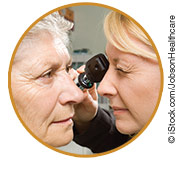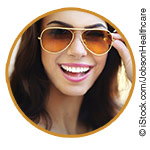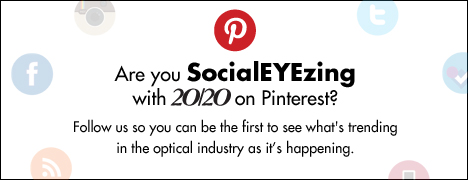|
Your monthly guide to staff training outside the box
Eyes / Lenses / Fitting Lenses / Free-Form / Frames / Sunwear / Patient Solutions/ In-office / Standards
LENSES: Trends
It seems that every month is a new lens innovation or solution for the results of new research; for example, the constant improvements to photochromics, free-form or the immediate availability of new anti-reflective blue light attenuating coatings or materials. Lenses provide a constant buzz and new business options. Incorporate these opportunities as fast as you can.
—Mark Mattison-Shupnick
RETAIL EXPERIENCE CHANGES
How will we address the forces that are changing the retail experience? How do we summarize this in a single word? It’s all about the consumer.
At the end of the day, we are dealing in an environment where we have a very unique combination between medical and retail. There is an invisible wall right in between, that consumer enters as a consumer, then becomes a patient and then becomes a consumer again, when they are asked to “shop” for a frame.
Unfortunately, a large percentage of these patients never make the transition back to consumer. They stay patients, they live in the world of need, they do not understand the value and the desire of the want, and all of a sudden they ask for a prescription and they walk. One in three patients walk out the door. How do we avoid that part? How do we capture the potential?
Watch the “Art of Retailing”.
|
LIVING TO 100?

How many of you or your patients will live to be 100 years old? It’s estimated that by the year 2030, the number of 100-year-olds in the U.S. will quadruple from the estimated 50,000-plus in 2000. What will be the opportunity for visual independence for this population and those following close behind in their 70s, 80s and 90s? Clearly, one must provide solutions for the potential accumulated effects of UV and HEV blue light.
See Plus »
|
|


|
LIGHT REACTIVE LENSES
Light reactive lenses are an important patient benefit and one that is still underserved; after all, the penetration of photochromics is only about 20 percent of all lenses sold. From Best Practices, Spectacle Lens Management (2015, Practice Management Associates), the best independent practices have as many as 35 percent of all their patients in photochromic lenses. Think of your practice and the opportunity to increase sales. After all, with great light reactive lenses, the opportunity is one of just demonstrating and teaching the benefits. Who benefits? Patients!
See Plus »
|
POLARIZED LENSES — FOR SUN, ALWAYS 100% UV PROTECTIVE

Seventy-five percent of Americans are concerned about UV eye exposure, but only 31 percent wear sunglasses every time they go outdoors (The Vision Council).
The protection from damaging UVA and UVB is necessary for anyone who spends a lot of time around water and snow. Due to the reflective nature of these environments, wearers are subjected to much more incident light radiation than those who vacation or infrequently visit these types of areas.
This is also very important to consider at higher altitudes where the UV and visible light is much more intense. Sunlight includes potentially damaging high-energy blue-violet radiation (415 to 455 nm) of concern by ECPs and a predominant conversation with patients using digital devices. Polarized lenses filter this light, associated with retinal damage. This makes for another crucial talking point when recommending polarized lenses to the wearer.
See Plus »
|
RIMLESS: WHATEVER YOU WANT IT TO BE
There is hope for those patients who want to define themselves and not allow their eyewear to do the work for them—rimless eyewear. Vintage may be what’s in fashion right now, but rimless eyewear has never really gone out of style—a subtle yet important distinction. A good weatherman can see which way the vane is blowing: Late ’80s and ’90s fashion have been slowly creeping back to life, and considering it was an era partially defined by subtle, often rimless eyewear, there’s no doubt that rimless will be back at the intersection of “fashionable” and “stylish” soon enough.
See Plus »
|
ATHLETES AS CONTACT LENS PATIENTS
Overall, athletes tend to be good patients. They are generally aware of their physical condition and have good hygiene. On the other hand, they may see a vision problem as a “defect” and try to hide it. Be sure to stress the need for follow-up care, care in handling the lenses and spare pairs. As much as possible, avoid lens or regimen changes mid-season.
Coaches and trainers should be educated about contact lens care and safety. Offer to meet with the coach or trainer to discuss how to handle ocular emergencies for contact lens wearers and lens insertion and removal. You can provide a contact lens “care kit” as part of the team’s medical supplies. Include cases, solutions, a penlight, tissues and printed information, irrigating solution, a mirror and your contact information. With little time and expense, you can have a coach or trainer who is a great source for referrals.
See Plus »
|
POSITION OF WEAR MEASUREMENTS
“The store is the stage, with scenery, lighting and music…”
Twenty-five percent of progressive lenses with personalized designs include actual vertex, tilt and wrap measurements, according to the most recent Premium Lens Survey from Jobson Research.
Now you might ask why we want to even take digital measurements for things that we already do so well such as PD and height. First are better fitting heights—did you know that height changes are the reason for most progressive lens redos? Shouldn’t we want a way that measures where the patient is actually reading? The best of digital lenses are better with personalized measurements. Patients notice, “No one’s ever done this before.” A request for only a PD for online eyewear makes just an adequate pair of glasses, and they help determine the opportunity for digital lenses. Five measurements (mono PD, mono height, vertex, tilt and wrap) make great eyewear and separates you from the competition.
See Plus »
|
FINDING THE RIGHT BLUE LIGHT SOLUTION FOR YOUR OFFICE
Everywhere you look you are inundated with information about how harmful blue light is for your visual system and your body in general when it comes to disruption of sleep cycles. You probably understand blue light is harmful, but might not be sure which products will work best in your office. Which products do what they claim and what should you tell your patients about them? So what’s a good optician to do? What we always do—find solutions for our patients.
See Plus »
|
TWICE THE RX
You’ve probably tried to increase your multiple pairs. But it either hasn’t worked, or worked for a short time while you focused on it until another focus was important. Perhaps that’s because in a Forbes article and in research by Jobson, 8 out of 10 patients have difficulty understanding their options and finding what they need.
Eyewear is a complicated business, isn’t it? However, 85 percent of patients want their ECP to inform them about all frame and lens options available regardless of price. What should you do? Sell frames and lenses to every patient. Of course that’s not possible since some patients are in for well visits or contact lens checks. But the practice would benefit if the number were greater than the 64 percent capture rate (currently the percent of patients purchasing after a comprehensive eye exam).
In fact, if that number were 100 percent, then the average revenue increase would be about $160,000. Only get halfway there—that’s still $80,000.
See Plus »
|
ARE YOU USING YOUR
SILENT SALES PEOPLE?
Advice from two seasoned professionals: an award winning visual display artist and an optician with sales and marketing experience.
Display and window designs are called “silent sales people” in the retail world, and they are used to communicate a message, form a visual image of a business, “invite” patients in and call attention to eyewear and other products. Looking outside our industry, we know that well-designed displays and windows propel sales. It is more than worth the time and investment to create optical displays that have an impact and draw patients into your dispensary.
Creating optical displays that spur lens sales requires creativity and savvy from your opticians—and support from practice owners. Consider hiring a person for the optical with a creative eye who would enjoy the challenge of coming up with displays with compensation for the work done. Practice owners need an understanding and willingness to promote and wear various fashion frames themselves and allow staff members a substantial discount (or provide them) to wear fashionable frames. Supplier reps can supply great looking posters and other point-of-sale materials.
See Plus »
|
|


|
|